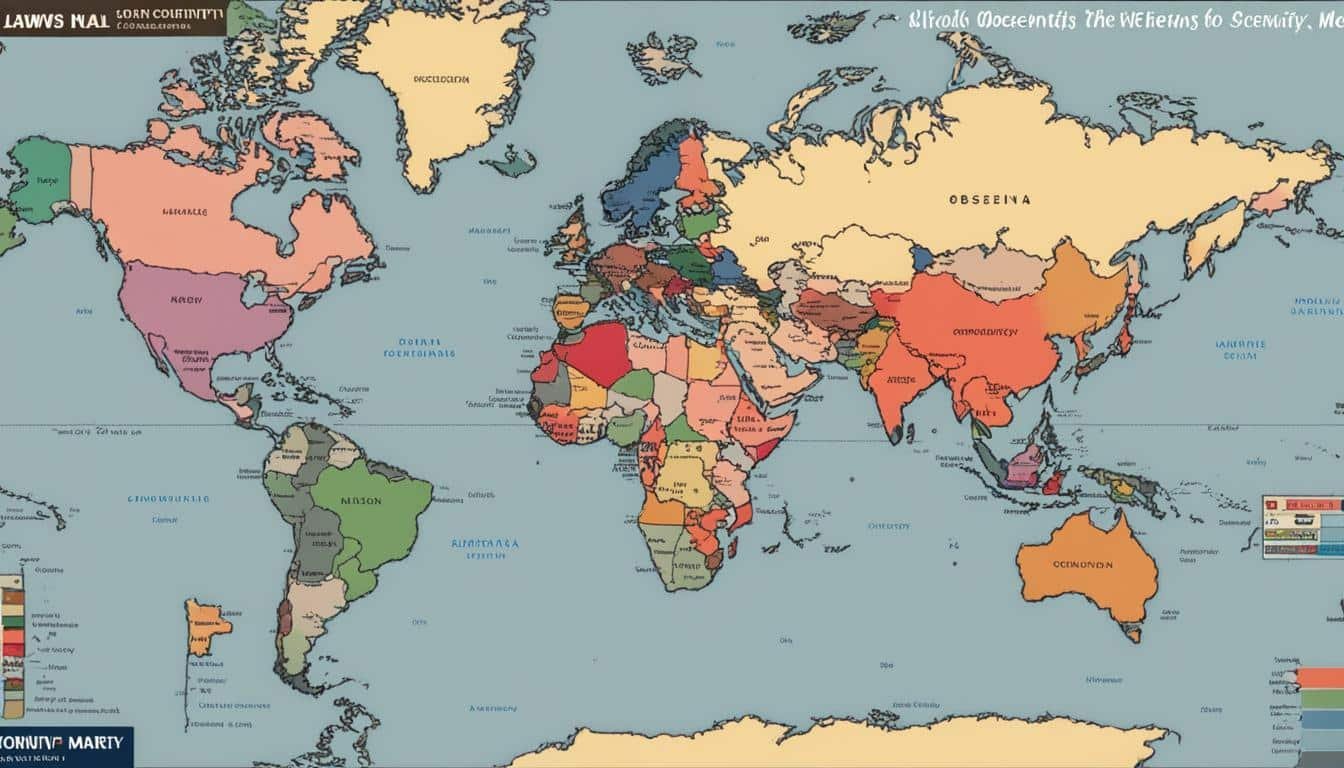When it comes to explicit materials, the legalities can vary greatly from one country to another. It is crucial to have a good understanding of obscenity laws and regulations on a global scale. In a recent comparative study, we examined several countries, including England, Wales, Australia, Canada, New Zealand, Scotland, Germany, the Netherlands, and the Republic of Ireland, to gain insight into how they define and deal with obscenity across different forms of media. Our findings revealed a diverse range of legal controls, classification and censorship organizations, approaches to prosecuting obscenity cases, criteria for defining obscenity, and systems for determining acceptability based on case law.
One common thread among these laws is the concern for protecting young people, with special legislation in place to address indecent photographs of children. Furthermore, the study shed light on the impact of technological advancements on accessing obscene material.
Key Takeaways:
- Obscenity laws and regulations vary across different countries
- Countries have different definitions and approaches to prosecuting obscenity cases
- Protection of young people is a common focus in obscenity laws
- Technological advancements have influenced the accessibility of obscene material
- The study examined several countries, including England, Wales, Australia, Canada, New Zealand, Scotland, Germany, the Netherlands, and the Republic of Ireland
Obscenity Laws in the United States
In the United States, obscenity laws are governed by federal regulations rather than being determined at the state level. These laws play a crucial role in restricting and penalizing the distribution, sale, and possession of explicit materials. It is important to understand the legal framework surrounding obscenity in the United States to ensure compliance and avoid criminal charges.
The cornerstone of obscenity laws in the United States is the Miller test. This three-pronged test is used by U.S. courts to determine whether material is considered obscene or falls under the protection of the First Amendment. The test examines whether the material appeals to prurient interests, depicts sexual conduct in a patently offensive way, and lacks serious literary, artistic, political, or scientific value. If a piece of media fails the Miller test, it is categorized as obscene and not protected under the freedom of speech.
In addition to the Miller test, federal law makes it illegal to distribute, transport, sell, or engage in the business of selling obscene material. The possession of obscene matter is generally not a criminal offense, but receiving such material through the mail or other means could violate federal laws. It is worth noting that the distribution of obscene material to minors, including over the Internet, is strictly prohibited. The Child Exploitation and Obscenity Section (CEOS) is responsible for enforcing federal obscenity laws and works in collaboration with other law enforcement agencies to ensure compliance.
Summary
Obscenity laws in the United States are based on federal regulations and are crucial in regulating and penalizing the distribution, sale, and possession of explicit materials. The Miller test is used by U.S. courts to determine whether material is considered obscene and not protected under the First Amendment. Federal law prohibits the distribution, sale, and business engagement of obscene material, with specific measures in place to protect minors from accessing explicit content. Compliance with these laws is essential to avoid criminal charges and maintain legal integrity in the United States.
| Key Points | Details |
|---|---|
| Obscenity Laws | Federal regulations govern obscenity laws in the United States. |
| The Miller Test | The Miller test is used to determine whether material is considered obscene. |
| Prohibited Activities | The distribution, sale, and business engagement of obscene material are illegal under federal law. |
| Protecting Minors | Specific measures are in place to prevent minors from accessing explicit content. |
| Law Enforcement | The Child Exploitation and Obscenity Section (CEOS) enforces federal obscenity laws in collaboration with other agencies. |
Prosecution and Penalties for Obscenity Offenses
Violating federal obscenity laws in the United States carries severe penalties, particularly when minors are involved. If you distribute, produce, or possess obscene material with the intent to sell or distribute, you can face heavy fines and imprisonment. It’s important to remember that possession or distribution of obscenity through the mail, common carriers, or interactive computer services is also a criminal offense.
Additional restrictions exist for broadcasting or distributing obscene matter through radio communication, cable, or subscription television. These measures are in place to safeguard minors from explicit content. In fact, federal law makes it illegal to create or possess visual representations that appear to depict minors engaged in sexual activity.
Offenders convicted of obscenity crimes involving minors may be required to register as sex offenders. It’s crucial to understand that the standard for what is considered harmful to minors differs from that applied to adults. Consequently, offenders could potentially face additional charges under federal child pornography laws.
Source Links
- https://www.ojp.gov/ncjrs/virtual-library/abstracts/testing-obscenity-international-comparison-laws-and-controls
- https://www.justice.gov/criminal-ceos/obscenity
- https://www.justice.gov/criminal/criminal-ceos/citizens-guide-us-federal-law-obscenity







